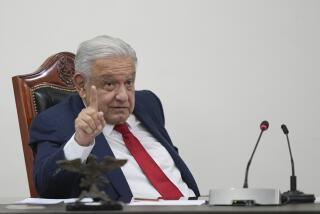Regular Guy Takes Extraordinary Approach
- Share via
Dropping the etiquette and formality often associated with Mexican government officials, the consul in Santa Ana opened his office Wednesday to anyone who needed his help or wanted to speak with him personally.
By 9 a.m., 75 people -- most in need of photo identification from the Mexican government -- had taken Luis Miguel Ortiz Haro up on his offer.
For hours, they stood in a stairwell waiting for him, eating snacks such as mango with chile or feeding babies.
While some were helped by consulate staff, about 30 talked one-on-one with Ortiz Haro, who said his only time constraint was a 7 p.m. English class he’s taking at Santa Ana College.
Ladia Montes, a mother of 12 and grandmother of 40 who came from San Fernando Valley to talk about the criminal conviction of two sons, likened the opportunity to sit with Ortiz Haro to “meeting God.”
Mexican officials are often seen as being rigidly formal and out-of-reach to the average citizen. But Ortiz, who arrived in Santa Ana in September with no diplomatic experience and only rudimentary English-speaking skills, was hardly that.
Wearing an open shirt, Ortiz Haro met his visitors with casual greetings such as “mamacita,” and “papito.” He wrote down their concerns in a spiral-bound notebook and promised to look into them. An assistant from a local legal office was on hand to provide additional advice.
“There are people who need to be heard and we need to support them,” said Ortiz Haro. “Mexican people need to speak in a way that is culturally understood.”
The consul said he will reserve Wednesdays to meet face-to-face with visitors who need his help. The newly launched initiative is known as Miercoles Paisano, roughly translated as Compatriot Wednesdays. Marcela Celorio, an officer with the Mexican embassy in Washington, said it appears to be unique among the 47 other consulates in the United States.
Many who showed up to meet with Ortiz Haro said they were stuck in one government quagmire or another, often unable to get photo identification because they came to the United States illegally.
The consul told many how they could qualify and obtain a Mexican identification card, or matricula consular. The card can be used to obtain bank and utility accounts and process other transactions.
Sandra Soto, who had no photo identification, said she had problems getting a tax identification number from the Internal Revenue Service. Ortiz Haro promised to get the ball rolling by contacting officials in her native state of Aguascalientes.
“This is what you get for sending your wife out to work,” he said jokingly to her husband, Jesus Najera.
Juan Carlos Valdez, an 18-year-old high school graduate who said he works two jobs 16 hours a day, had to negotiate with his employers for a day off work to meet Ortiz Haro. It paid off.
Just hours before he was to meet with U.S. immigration officials, Valdez met with Ortiz Haro and asked for his help getting a Mexican government card. Told he needed further proof of identity, Valdez ran across Santa Ana to collect his school records and sprinted back in time to get his Mexican photo identification card.
“I was really surprised because I just figured, it’s government,” said Valdez, wearing an oversized sports jersey, baseball cap and three earrings. “I never thought it would work out.”
More to Read
Sign up for Essential California
The most important California stories and recommendations in your inbox every morning.
You may occasionally receive promotional content from the Los Angeles Times.













